 |
 |
Our enthusiastic and extremely knowledgeable perennials team is here to answer your questions and help you choose the best perennials for your situation. There’s always something in bloom for sun, shade, butterflies, birds or deer resistance as well as a variety of bulbs for your space.
Stroll through our time-tested favorites and introduce yourself to the newest varieties. We garden with perennials too; we love them and it shows!
|
68 found, showing page 4 of 5
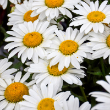
Plant Height: 12 inches
Flower Height: 18 inches
Spacing: 16 inches
Sunlight: full sun, partial shade
Hardiness Zone: 4a
Description:
A delightful variety of the ever-popular shasta daisy known for a high bloom rate; abundant beautiful white blooms with yellow eyes rise above and graciously contrast the deep green foliage; wonderful choice to mass as a garden focal point
Ornamental Features:
Snowcap Shasta Daisy has masses of beautiful white daisy flowers with yellow eyes at the ends of the stems from early to late summer, which are most effective when planted in groupings. The flowers are excellent for cutting. Its serrated narrow leaves remain dark green in color throughout the
season.
Landscape Attributes:
Snowcap Shasta Daisy is an herbaceous perennial with an upright spreading habit of growth. Its medium texture blends into the garden, but can always be balanced by a couple of finer or coarser plants for an effective composition.
This plant will require occasional maintenance and upkeep, and should be cut back in late fall in preparation for winter. It is a good choice for attracting butterflies to your yard. Gardeners should be aware of the following characteristic(s) that may warrant special consideration:
-Insects
Snowcap Shasta Daisy is recommended for the following landscape applications:
- Mass Planting
- Border Edging
- General Garden Use
- Container Planting
Planting & Growing:
Snowcap Shasta Daisy will grow to be about 12 inches tall at maturity extending to 18 inches tall with the flowers, with a spread of 18 inches. When grown in masses or used as a bedding plant, individual plants should be spaced approximately 16 inches apart. It grows at a fast rate, and under ideal conditions can be expected to live for approximately 5 years. As an herbaceous perennial, this plant will usually die back to the crown each winter, and will regrow from the base each spring. Be careful not to disturb the crown in late winter when it may not be readily seen!
This plant does best in full sun to partial shade. It does best in average to evenly moist conditions, but will not tolerate standing water. It is not particular as to soil type or pH. It is highly tolerant of urban pollution and will even thrive in inner city environments. This particular variety is an interspecific hybrid. It can be propagated by division; however, as a cultivated variety, be aware that it may be subject to certain restrictions or prohibitions on propagation.
Snowcap Shasta Daisy is a fine choice for the garden, but it is also a good selection for planting in outdoor pots and containers. It is often used as a 'filler' in the 'spiller-thriller-filler' container combination, providing a mass of flowers against which the larger thriller plants stand out. Note that when growing plants in outdoor containers and baskets, they may require more frequent waterings than they would in the yard or garden.
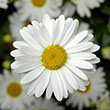
Height: 20 inches
Spacing: 18 inches
Sunlight: full sun, partial shade
Hardiness Zone: 4b
Group/Class: Western Star Series
Brand: Syngenta
Description:
An exceptional series noted for superior habits and flowering; a beautiful addition to the garden when massed; blooms throughout the summer
Ornamental Features:
Western Star Taurus Shasta Daisy has masses of beautiful white daisy flowers with gold eyes at the ends of the stems from mid spring to mid summer, which are most effective when planted in groupings. The flowers are excellent for cutting. Its serrated narrow leaves remain dark green in color throughout the season.
Landscape Attributes:
Western Star Taurus Shasta Daisy is an herbaceous perennial with an upright spreading habit of growth. Its medium texture blends into the garden, but can always be balanced by a couple of finer or coarser plants for an effective composition.
This plant will require occasional maintenance and upkeep. Trim off the flower heads after they fade and die to encourage more blooms late into the season. It is a good choice for attracting butterflies to your yard. Gardeners should be aware of the following characteristic(s) that may warrant special consideration:
- Insects
Western Star Taurus Shasta Daisy is recommended for the following landscape applications:
- Mass Planting
- Border Edging
- General Garden Use
- Container Planting
Planting & Growing:
Western Star Taurus Shasta Daisy will grow to be about 16 inches tall at maturity, with a spread of 20 inches. When grown in masses or used as a bedding plant, individual plants should be spaced approximately 18 inches apart. It grows at a fast rate, and under ideal conditions can be expected to live for approximately 5 years. As an herbaceous perennial, this plant will usually die back to the crown each winter, and will regrow from the base each spring. Be careful not to disturb the crown in late winter when it may not be readily seen!
This plant does best in full sun to partial shade. It does best in average to evenly moist conditions, but will not tolerate standing water. It is not particular as to soil type or pH. It is highly tolerant of urban pollution and will even thrive in inner city environments. This particular variety is an interspecific hybrid. It can be propagated by division; however, as a cultivated variety, be aware that it may be subject to certain restrictions or prohibitions on propagation.
Western Star Taurus Shasta Daisy is a fine choice for the garden, but it is also a good selection for planting in outdoor pots and containers. With its upright habit of growth, it is best suited for use as a 'thriller' in the 'spiller-thriller-filler' container combination; plant it near the center of the pot, surrounded by smaller plants and those that spill over the edges. Note that when growing plants in outdoor containers and baskets, they may require more frequent waterings than they would in the yard or garden.
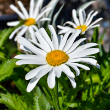
Height: 18 inches
Spacing: 15 inches
Sunlight: full sun, partial shade
Hardiness Zone: 4b
Group/Class: Lucille Series
Brand: Danziger
Description:
An outstanding, profuse bloomer presenting large single white flowers with golden centers; a beautiful addition to the garden when massed; hardy and blooms throughout the summer
Ornamental Features:
Lucille White Shasta Daisy has masses of beautiful white daisy flowers with gold eyes at the ends of the stems from late spring to mid fall, which are most effective when planted in groupings. The flowers are excellent for cutting. Its serrated narrow leaves remain dark green in color throughout the season.
Landscape Attributes:
Lucille White Shasta Daisy is an herbaceous perennial with an upright spreading habit of growth. Its medium texture blends into the garden, but can always be balanced by a couple of finer or coarser plants for an effective composition.
This plant will require occasional maintenance and upkeep, and should be cut back in late fall in preparation for winter. It is a good choice for attracting butterflies to your yard. Gardeners should be aware of the following characteristic(s) that may warrant special consideration:
- Insects
Lucille White Shasta Daisy is recommended for the following landscape applications:
- Mass Planting
- Border Edging
- General Garden Use
- Container Planting
Planting & Growing:
Lucille White Shasta Daisy will grow to be about 15 inches tall at maturity, with a spread of 18 inches. When grown in masses or used as a bedding plant, individual plants should be spaced approximately 15 inches apart. It grows at a fast rate, and under ideal conditions can be expected to live for approximately 5 years. As an herbaceous perennial, this plant will usually die back to the crown each winter, and will regrow from the base each spring. Be careful not to disturb the crown in late winter when it may not be readily seen!
This plant does best in full sun to partial shade. It does best in average to evenly moist conditions, but will not tolerate standing water. It is not particular as to soil type or pH. It is highly tolerant of urban pollution and will even thrive in inner city environments. This particular variety is an interspecific hybrid. It can be propagated by division; however, as a cultivated variety, be aware that it may be subject to certain restrictions or prohibitions on propagation.
Lucille White Shasta Daisy is a fine choice for the garden, but it is also a good selection for planting in outdoor pots and containers. It is often used as a 'filler' in the 'spiller-thriller-filler' container combination, providing a mass of flowers against which the larger thriller plants stand out. Note that when growing plants in outdoor containers and baskets, they may require more frequent waterings than they would in the yard or garden.

Heat and humidity tolerant, mounding habit, and periwinkle blue blooms appearing late spring. Near-Black Stems. USDA 4-9
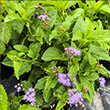
Bright blue minty leaves with purplish stems topped with masses of powder blue fuzzy flowers. Height 2-3'.
Eupatorium attracts bees and butterflies. Needs moisture if grown in full sun. Drought tolerate in shadier sites. Deer and rabbit resistant.
- USDA Hardiness Zone(s): 4-9
- Exposure: Full Sun, Part Shade
- Bloom Time(s): August-October
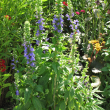
Tall spikes of blue blooms. Tolerates moist to wet soils. Native. USDA 4-9
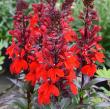
Scarlet blooms on flushed bronze foliage. Tolerates wet soils. USDA 5-8
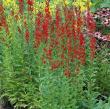
Scarlet-red bloom on green foliage. Prefers rich, humusy, medium to wet soils. Great for rain gardens. USDA 3-9
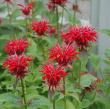
Height: 4 feet
Spacing: 30 inches
Sunlight: full sun partial shade
Hardiness Zone: 3a
Other Names: Bergamot, Oswego Tea
Ornamental Features:
Jacob Cline Beebalm has masses of beautiful clusters of fragrant red flowers at the ends of the stems from mid to late summer, which are most effective when planted in groupings. The flowers are excellent for cutting. Its fragrant pointy leaves remain forest green in color throughout the season.
Landscape Attributes:
Jacob Cline Beebalm is an herbaceous perennial with an upright spreading habit of growth. Its relatively coarse texture can be used to stand it apart from other garden plants with finer foliage.
This plant will require occasional maintenance and upkeep, and should be cut back in late fall in preparation for winter. It is a good choice for attracting bees, butterflies and hummingbirds to your yard, but is not particularly attractive to deer who tend to leave it alone in favor of tastier treats. Gardeners should be aware of the following characteristic(s) that may warrant special consideration: Spreading, Self-Seeding
Jacob Cline Beebalm is recommended for the following landscape applications:
- Mass Planting
- General Garden Use
- Naturalizing And Woodland Gardens
Planting & Growing:
Jacob Cline Beebalm will grow to be about 3 feet tall at maturity, with a spread of 3 feet. When grown in masses or used as a bedding plant, individual plants should be spaced approximately 30 inches apart. It grows at a fast rate, and under ideal conditions can be expected to live for approximately 5 years. As an herbaceous perennial, this plant will usually die back to the crown each winter, and will regrow from the base each spring. Be careful not to disturb the crown in late winter when it may not be readily seen!
This plant does best in full sun to partial shade. It is very adaptable to both dry and moist locations, and should do just fine under typical garden conditions. It is not particular as to soil type or pH. It is highly tolerant of urban pollution and will even thrive in inner city environments. This particular variety is an interspecific hybrid. It can be propagated by division; however, as a cultivated variety, be aware that it may be subject to certain restrictions or prohibitions on propagation.
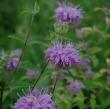
Showy clusters of lavender, pink or white pom pom flowers. Aromatic leaves. Native. Clay tolerant. USDA 3-9
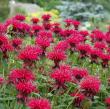
Magenta blooms. Fragrant foliage. Mildew resistant. USDA 4-9
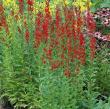
Scarlet-red bloom on green foliage. Prefers rich, humusy, medium to wet soils. Great for rain gardens. USDA 3-9
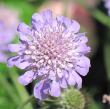
Lavender blooms. Long blooming. Compact. Clump-forming. USDA 5-9
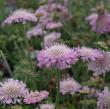
Pale-pink blooms. Long blooming. Compact. Clump-forming. USDA 5-9
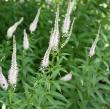
Elegant and showy soft spikes of white, pale pink, or bluish purple flowers. Provides a strong accent and good vertical height. USDA 3-8
68 found, showing page 4 of 5





